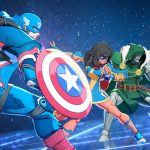Street Fighter 6 is lost in the Uncanny Valley and needs to come back
Capcom’s latest is going for a photorealistic aesthetic with questionable results but there’s an obvious, easy fix
KOSTAS FARKONAS
PublishED: June 20, 2022

So, after that insult of an announcement trailer back in February, Street Fighter 6 was officially unveiled during Sony’s June State Of Play a few days ago and the SF community is understandably excited: not only are we getting a brand new Street Fighter next year, but it already seems to be among the most interesting ones in the history of the franchise (let’s leave the new control scheme option aside for a bit) with plenty of new characters, some fresh gameplay mechanics and a different vibe overall. There is one thing that nobody seems to be talking about, though, and that’s the new art direction of the game. Which is as weird an observation as SF6’s art direction itself.
In short, then: Street Fighter 6 uses Capcom’s own Resident Evil graphics engine, which is a modern, photorealistic-oriented system focused on high-polygon models, detailed surfaces and textures, convincing multi-source lighting as well as over-the-top, cinematic effects. The RE engine is great, having served Capcom well in not just the last few Resident Evil games, but Devil May Cry 5 too and even Monster Hunter Rise for the Nintendo Switch. It’s a powerful, flexible, capable engine worthy of note.

The problem is that the way it’s used in Street Fighter 6 is currently not ideal because of the choices Capcom has made regarding the game’s graphics and its overall presentation. The company’s artists have gone for a look that is… well, peculiar to say the least. It aspires to be photorealistic but it’s also anime-stylized, so models are high-polygon but of exaggerated proportions, which is visually confusing: it’s somewhere between Tekken and Mortal Kombat, without dropping the pretenses of photorealism (as the former does) or going for almost lifelike character models (like the latter does).
The effect is jarring: Street Fighter 6 characters seem to be too glossy or shiny much of the time — as if they are wet or oiled for no apparent reason — while looking plasticky in some situations… but also faintly glowing or downright swimming into literal photorealistic effects in other situations. Stages, meanwhile, do not strive to be any more photoreal than what people come across in most other types of games today: they are well-designed but polygon counts or textures are decidedly common-looking, their detail nowhere near the level the characters themselves are going for.

Adding to the visual confusion is the stark contrast of the effects that explode on-screen when special moves or counters are executed: these are depicted in a much flatter, painterly style that’s eerily reminiscent of comics or the visual style of Spider-man: Into the Spider-Verse but even more inky, vibrant and striking. It’s an absolutely beautiful effect and, yes, its contrast does make the moves seem more dramatic, but it is so over the top that it ends up being distracting. Given the fact that counters, supers, specials and the like will be happening much more often in SF6 because of the new Drive system, this effect will most probably grow old quickly and even disrupt the flow of matches considerably.
But it’s admittedly Street Fighter 6’s characters that alienate the most. There’s a term in aesthetics called Uncanny Valley: it was originally created in the context of advanced robotics and android development but it came to mean something broader in the world of special effects during the last decade or so. As visual technology approaches photorealism it’s become easier to put one’s mind into “make-believe” mode — as we do while watching Marvel movies, for instance — but the human brain still picks out details that are either missing or don’t quite nail it, leading to a sense of disconnect or dismissal even.

This is what watching Street Fighter 6 matches feels like right now: a walk into Uncanny Valley. Fighters are not photorealistic in the literal sense but they are not designed as “just” detailed gamey characters either, so they end up looking bizarre, unnatural. Fighters being proportionally stylized anyway further adds to the visual discrepancy between the modern, edgy look Capcom is obviously going for and a more aesthetically balanced approach that would probably serve SF6 players better in the long run.
Luckily, there seems to be a way out of this and it all boils down to a single word: uniformity. The look Capcom is going for can definitely work if characters are not quite so shiny, if lighting effects are toned down considerably, if the Drive system effects become much less pronounced and quite a bit less painterly or contrasty. Fighters do not need to be presented in near-photorealism in order to look detailed and impressive. Special moves effects don’t have to take up the entire screen in order to signify their importance. Characters and stages getting more in line with one another in terms of graphical detail is not too much to ask.

Thankfully, SF6 having more than eight or nine months of development ahead of it means that its visual look can easily be balanced and tuned into something more coherent. It’s clear that the edgy style Capcom has chosen for the next Street Fighter will largely stay the same, but some consistency between the different parts of its graphics and presentation would go a long way. Now, if only the company could be talked into offering a Settings option that displays all in-game graphics in the Spider-Verse style…



















